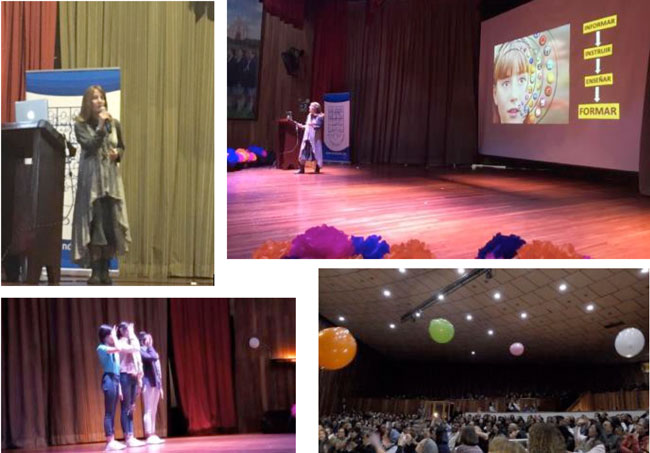Reflections From A Conference In Bogotá, Colombia
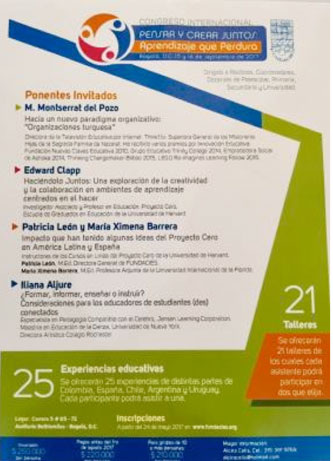 Last April, I received an invitation from Patricia León, Ma. Ximena Barrera and Adriana Salazar, members of a recognized educational research group in Colombia, called Fundacíes, who have been leaders in our country in organizing national / international conferences, workshops and on going professional trainings since 1994, to be one of the keynote speakers on their upcoming national education event, to be held on September 15th and 16th, 2017. I was gladly surprised and said yes! The title of this international conference would be “Think and Create Together: Learning that Lasts”.
Last April, I received an invitation from Patricia León, Ma. Ximena Barrera and Adriana Salazar, members of a recognized educational research group in Colombia, called Fundacíes, who have been leaders in our country in organizing national / international conferences, workshops and on going professional trainings since 1994, to be one of the keynote speakers on their upcoming national education event, to be held on September 15th and 16th, 2017. I was gladly surprised and said yes! The title of this international conference would be “Think and Create Together: Learning that Lasts”.
I immediately started to think about the topic, knowing for sure that brain based learning would be one of the things I would love to give information about. I also had been researching on our actual student generation, commonly known as GEN Z or the centennials, because being a teacher for the past 30 years, has taught me to analyze the great challenge it is to give out information to this new connected group of students. The last 8 to 10 years have been demanding considering that even though, teaching a subject area might have the same topics, the way we do it, has drastically evolved. It has been a rapid change for those of us who have been educating for many years. Not harder, not more difficult, just very different.
So I finally decided on a topic that linked many things I have read about, summarizing my experience as a dance teacher and artistic director of Rochester School in Bogotá, Colombia, and my training as a brain based specialist at the Jensen Learning Corporation since 2007, particularly the role of the brain seeking satisfaction, emotional states and social environments, turning into this, as follows:
Title: Train, Inform, Teach or Instruct? Considerations for Educators of (dis) Connected Students
Conference Description: To be a teacher today represents great challenges and methodological implications in the way we transmit knowledge. What type of teaching is really relevant for the generation of “millennials” and “centennials”?
What do we inform in an era where knowledge is a “click” away? How can we “connect” with them despite the fact they are permanently connected? What type of students will be successful in the future? We will review authors like Michelle Borba, Howard Gardner, Carol S. Dweck, Amy Banks, Martin Seligman, Angela Duckworth and Paul Ekman, to figure out and discover what we can do to become inspiring teachers.
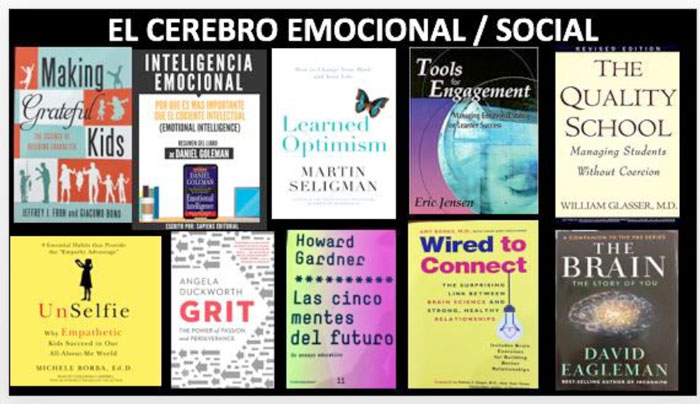
Screen Shot of one of the slides referring to bibliography used
During the process of constructing the keynote, I had to read articles and books, which confronted me with the profound changes we as educators, have had to do in order to engage a new generation of learners. As a dance teacher, I selected three 7th grade female students to work on a choreography that showed the audience the impact of the use of cell phones in their everyday life. After explaining them my responsibility, we came up with a collaborative creation (which is attached to this article), where they instructed me what they do with those devices at their homes, in their recess hours at school and the behavior they engage in with their peers on its use. We also worked on teaching movements to the audience so they could memorize better the premises that Michelle Borba talks about in her book UNSELFIE, to help children of this generation to develop more empathy towards people. I cannot tell you how much the four of us learned from this collaborative experience.
Some of the topics I shared with the audience after my research, are:
- Millennials – Born between 1981 and 1995. Represent 30% of the work force in Latin America and according to Deloitte Consultants firm, they will represent 75% of the work force globally in 2025. They are “digital immigrants” according to Mark Prensy, they are multitask and multi-device, extremely digital social citizens and app addiction.
- Centennials – Born after 1996 and represent 25% of the population actually. They are the most conservative generation in the last 70 years being aware of the planet they inherited (security is one of their main issues), ask and question all the information they receive (google is their life searching for quick answers) and belong to the digital world since they were born managing around 7 social media networks at a time, reason why they are also called the iGeneration.
- Since children today spend many hours interacting with their different devices, authors like Michelle Borba, in the book I mentioned previously, introduce us to the need of changing that “selfie world” into a “we world” to build empathy around us, which in the end is what she considers will impact positively our society, if we teachers in our schools, work on 8 premises, as follows:
3.1. Emotional literacy
3.2. Moral identity
3.3. Perspective taking
3.4. Moral imagination
3.5. Self – regulation
3.6. Practicing kindness
3.7. Collaboration
3.8. Moral courage
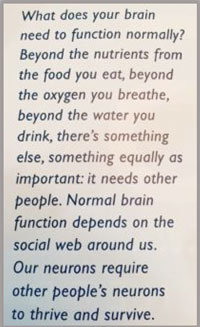 The survival of our species, according to David Eagleman in his book “The Brain – The Story of You”, relies on our emotional/social tuning since birth, fostering our ability to think, work and create together. In page 12, he shares the conclusion of Dr. Charles Nelson, professor of Pediatrics at Boston Children’s Hospital, who in 1999 did a research in the orphanage institutions in Bucharest, Romania, where children were separated from their parents to be held in cribs with no movement, no stimulation or love of any kind, under the care of one person for every 15 children. The profound impact he found was literally described as follows: “Nelson’s results highlight the critical role of a loving, nurturing environment for a developing child’s brain. We are exquisitely sensitive to our surroundings. Because of the wire- on-the-fly strategy of the human brain, who we are depends heavily on where we’ve been.” In addition to that, on page 133, Dr. Eagleman writes an amazing quote, posted on the right side of the paragraph:
The survival of our species, according to David Eagleman in his book “The Brain – The Story of You”, relies on our emotional/social tuning since birth, fostering our ability to think, work and create together. In page 12, he shares the conclusion of Dr. Charles Nelson, professor of Pediatrics at Boston Children’s Hospital, who in 1999 did a research in the orphanage institutions in Bucharest, Romania, where children were separated from their parents to be held in cribs with no movement, no stimulation or love of any kind, under the care of one person for every 15 children. The profound impact he found was literally described as follows: “Nelson’s results highlight the critical role of a loving, nurturing environment for a developing child’s brain. We are exquisitely sensitive to our surroundings. Because of the wire- on-the-fly strategy of the human brain, who we are depends heavily on where we’ve been.” In addition to that, on page 133, Dr. Eagleman writes an amazing quote, posted on the right side of the paragraph:
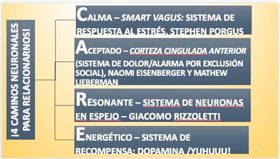 We are wired to connect! Amy Banks, M.D. in her book with the same name of the phrase I used to begin this idea, on the first chapter, refers to mirror neurons as crucial to understand and relate to other people’s feelings, in order to be able to build strong relationships among humans, according to the famous findings of Giacomo Rizzolatti at the Parma lab back in 1998. In page 7, she replicates the phrase of Marco Iacoboni, a psychiatry professor at UCLA, who says that “the mirroring system helps us in understanding our existential condition and our involvement with others. It shows that we are not alone, but we are biologically wired and evolutionarily designed to be deeply interconnected with one another”. Aside from the mirroring system, she describes other three neural pathways that are hard wired in humans, from which she developed the C.A.R.E. plan to build strong relationships: Calm, Accepted, Resonant, Energetic.
We are wired to connect! Amy Banks, M.D. in her book with the same name of the phrase I used to begin this idea, on the first chapter, refers to mirror neurons as crucial to understand and relate to other people’s feelings, in order to be able to build strong relationships among humans, according to the famous findings of Giacomo Rizzolatti at the Parma lab back in 1998. In page 7, she replicates the phrase of Marco Iacoboni, a psychiatry professor at UCLA, who says that “the mirroring system helps us in understanding our existential condition and our involvement with others. It shows that we are not alone, but we are biologically wired and evolutionarily designed to be deeply interconnected with one another”. Aside from the mirroring system, she describes other three neural pathways that are hard wired in humans, from which she developed the C.A.R.E. plan to build strong relationships: Calm, Accepted, Resonant, Energetic.
- Howard Gardner, in his book “Five Minds for the Future”, tells us that having a respectful mind with the capacity for empathy, the ability to work in teams cooperatively and having an open mind for cultural and social diversity, is going to be crucial for the future generations to survive. On the other hand, Angela Duckworth in her famous book “Grit”, illuminates us on the importance of promoting and teaching grit, a combination of passion and perseverance, as a key element in the picture of having a successful and happy life.
- Eric Jensen, in his 6 day workshop of Teaching with the Brain in Mind, addresses 12 brain based principals that help teachers understand how to deliver information according on how the brain works. Principles # 2, # 8 and # 12, respectively described by him as the brain seeks satisfaction, environments counts and emotional states rule, play a big role in terms of how predominant the social/emotional learning is for our students. In many of his books, he talks about this important topic: Teaching with the Brain in Mind, Brain Based Learning, Tools for Engagement, among others.
So to summarize, being coherent with one of the thought lines of my conference, what type of students will be successful in the future? Definitely those who can understand and apply the concept that relationships are key to human nature; those who can practice random acts of kindness and service everyday; those who are willing to comprehend that empathy will always prevent misunderstandings in order to construct a peaceful society; those who are passionate and determined to pursue relevant goals that serve humanity; those who help promote the importance of the “we” instead of the “I”; those who use social media in a respectful way honoring what a digital citizen really means; those who are impeccable with their words and acts towards others; those who are emotionally and socially educated to embrace diversity and those who are willing to work collaboratively in order to preserve and maintain our planet.
I strongly believe that we as educators, can help shape the hearts, minds and bodies of our students, so that they can become well rounded, healthy, ethical and empathetic individuals, showing integrity in all they pursue.
I dream, I imagine, I believe…
